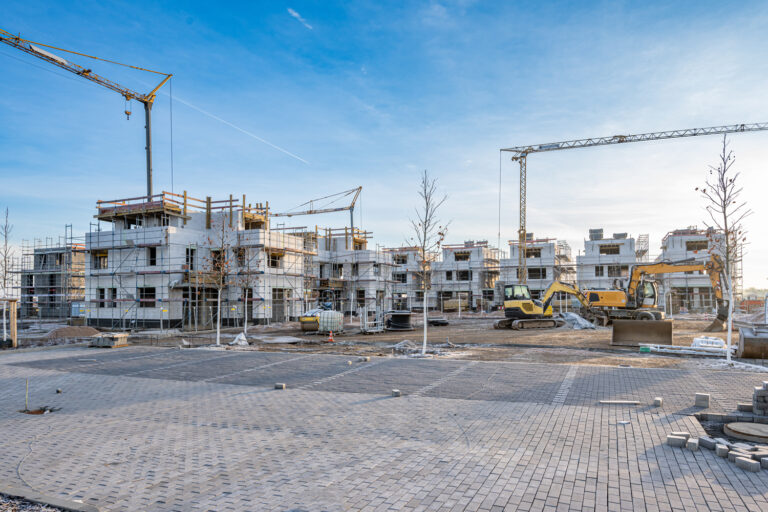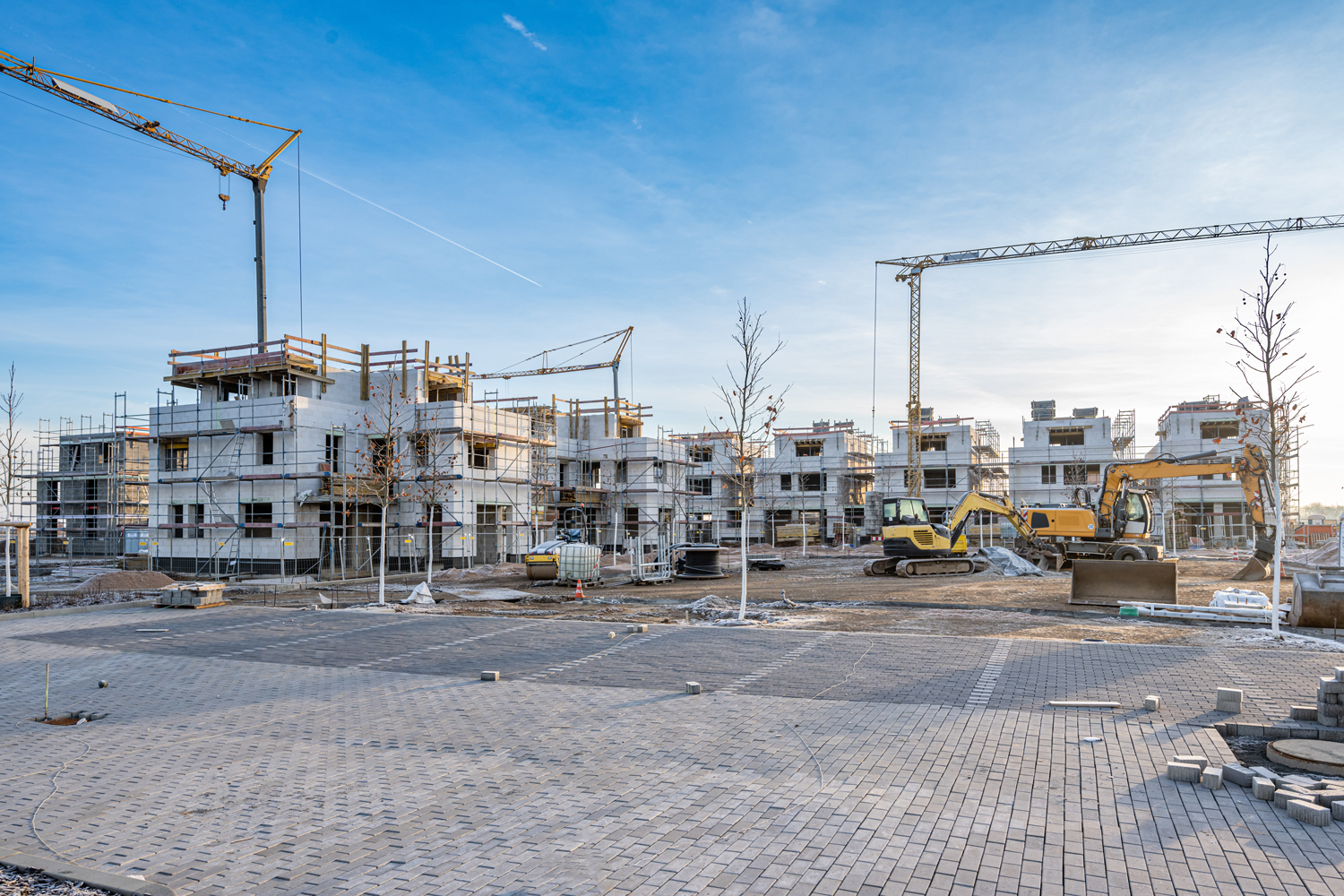Residential Investments in Germany – September 2023
12. Sep 2023

12. Sep 2023

Dear Readers,
News and industry media have been full of stories about the “crisis on real estate markets” since interest rates started to rise a year or so ago. There is no question that the “golden decade” is over, market data are weak and many prominent developers have already filed for bankruptcy. In new construction, there is indeed a crisis. In the market for existing properties, the situation is different. Prices for existing buildings have fallen noticeably. In major cities such as Berlin, the downturn in prices now appears to have bottomed out. But the current market situation does not have much to do with the crises of the past.
After more than ten years of a super cycle of steadily rising prices and falling initial yields on the residential investment markets, we are now experiencing a phase in which prices have corrected significantly and in which the money to finance acquisitions comes at a cost again. At the same time, demand for housing continues to rise unabated, and with it rents. There is no question of widespread vacancies and abandoned, unfinished new-builds, as was the case during the real estate crisis at the turn of the millennium. On the contrary, since new housing construction has come to a virtual standstill, the pressure is likely to continue to mount.
Back to the more recent past: the period before the latest cycle of interest rate hikes was by no means short of challenges for potential housing market investors. After all, in some cities price-to-rent ratios reached horrendous levels of up to 40 times net annual rent and more. For private investors, an entire working life can pass before their investment is actually amortised – and that’s without the cost of renovation measures over the years.
The time has now come for buyers to enjoy more favourable conditions – provided they have sufficient equity. For many experienced investors, the time is now ripe to re-enter the market.
Jürgen Michael Schick & Holger Friedrichs

Sascha Hertach | Member of the Management Board, Arbireo Capital AG
In no time at all, the German real estate market has changed completely. A weakening economy, rising financing costs and ongoing uncertainty are currently dictating the market. Some industry players have little choice but to accept more expensive refinancing conditions for their projects, while others are even being forced to sell properties at discounts in some cases. All the more reason for real estate investors to act as active asset managers in order to identify and exploit truly rewarding opportunities in these challenging times. Whereas just a few years ago all you had to do was acquire a property in an attractive location and monitor its performance, new strategies are now necessary.
More selective acquisition strategies are what is needed
As positive as the mood in the real estate industry was just a few years ago, managing a portfolio has never been a walk in the park. Given the comparatively low initial yields, no investor could really afford to blindly acquire a “rotten apple”, which, however, is often what happened with larger portfolio purchases – with the very real risk of pushing the entire portfolio’s overall performance into negative territory. This is even more the case today: in the wake of recent interest rate hikes, real estate investments are no longer a sure-fire success. Asset management expertise is once again required, especially if investors’ return expectations are to be met. There is currently an oversupply of overpriced properties on the real estate market and many properties have not yet been properly repriced to reflect the current market landscape. It is important to sound out the market carefully, to buy selectively and, if necessary, to initiate redevelopment measures at an early stage – which is why active portfolio management is also more important today than ever before.
In the current market situation, investors are no longer quite so convinced by the security of “concrete gold”: According to CBRE, around EUR 13 billion was invested in the German real estate markets in the first half of 2023, around 64 percent less than in the same period of the previous year.[1] Given the current interest rate environment, there is a higher downside risk of leveraging when it comes to debt financing. In addition, it is not yet possible to predict how high interest rates will actually rise. As a result, investors are increasingly focusing on government bonds, which once again offer attractive yields and are regarded as risk-free. However, bonds do not offer investors the opportunity to benefit from potentially inflation-busting capital gains, which can only be achieved, to some extent, through real estate investments.
Finding creative solutions
To remain attractive in comparison to competing products, residential real estate investments should yield in the region of 4.5 percent or more per annum. However, such yields are unlikely to be achievable in high-priced, Class A locations. It potentially makes far more sense for investors to focus on up-and-coming secondary locations with high yield potential. But even in Class C and D locations, the risk premium needs to pay off for the investor. It is therefore important to be very careful and very selective when choosing assets and locations, and to avoid obstinately adding to already oversized portfolios. In this respect, smaller investment houses can exploit their advantage of greater flexibility for small-scale investments with a planned exit strategy, as they do not necessarily need to achieve large transaction volumes. Instead, they can put together highly individualised products, tailored precisely to individual investors’ wants and needs.
In addition to focussing on emerging secondary locations, investors with special expertise can also target the stock of state-subsidised housing, which offers the potential of both asset price increases and “social returns”. In many cases, investors are increasingly weighing up a range of ancillary factors, such as a good ESG record, which includes social criteria. Sometimes they will even accept a small yield discount, because an investment in a state-subsidised project, such as student housing or inclusive housing, adds value to a portfolio. However, such opportunities in the field of publicly funded housing are not so readily available, as the funding landscape in Germany differs from state to state and it can take several months to complete the application processing including the approval permit. This makes it all the more important to have a professional and experienced asset manager on board.
Conclusion: opportunities still exist in the current market
The current market situation is not easy, but it is by no means without opportunities. However, since no portfolio can develop on its own or automatically achieve a steady increase in value, active asset management and a high level of expertise in the selection of real estate investments are indispensable. For example, there is great potential in many locations beyond Germany’s high-priced metropolitan regions. Investment opportunities also exist, for example, in the field of state-subsidised and inclusive housing, although these require a high level of expertise. Overall, smaller and independent providers in particular can benefit from their flexibility in real estate investments. To make the best possible use of potential, it is best if a provider is able to offer services that cover all of the stages of a real estate investment – including investment, portfolio, asset and project management. Closely integrating these services gives investors access to bespoke solutions from a single source, allowing them to more quickly seize promising investment opportunities in an ever-evolving market. Clearly, a challenging market environment requires proactive and needs-based approaches to deliver success and create long-term value.

Swen Nicolaus | Managing Shareholder / CEO / Regional Operating Principal, Keller Williams Deutschland
So far, the government has profited immensely from Germany’s real estate transfer taxes, which were raised in the wake of the real estate boom. However, instead of viewing this as a permanent source of revenue, politicians should be focussing on long-term goals – promoting home ownership and individual wealth accumulation.
Home ownership is a vital component in achieving broad-based financial security and avoiding poverty in old age. In international comparison, Germany’s home ownership rate lags far behind countries such as Norway and the Netherlands. We cannot afford to allow this state of affairs to continue.
There is a great desire for home ownership throughout our society, but it is often frustrated by seemingly insurmountable financial barriers. The hurdles facing would-be homeowners range from the knock-on effects of war and inflation to more direct factors such as rising interest rates and construction costs. In addition to these, however, it is primarily Germany’s excessive real estate transfer taxes that make purchasing residential property so difficult.
Real estate transfer taxes across Germany have increased more in some federal states than in others. Nevertheless, it has become a significant source of revenue across the board. Five federal states, namely Thuringia, Brandenburg, North Rhine-Westphalia, Schleswig-Holstein and Saarland, now have a real estate transfer tax rate of 6.5 percent – a figure that has almost quadrupled since 2005.
Even more pernicious is the mechanism of fiscal equalisation between the states, which actually favours increases in the real estate transfer tax. This has led to competition between federal states, which is not about fair tax rates but about maximising profits from real estate transactions.
In order to counteract this development, Federal Minister of Finance Christian Lindner has presented a promising draft of the real estate transfer tax system. Lindner’s proposed reforms would see reduced tax rates for owner-occupied residential property and even a tax rate of zero percent for first-time buyers. If it happens, this would trigger healthy competition between states and enable families to fulfil their dreams of owning their own home.
Now it’s up to the federal government to implement Lindner’s proposals quickly and with a minimum of bureaucracy. Promoting home ownership should not just be a political vision, but a practical measure to solve the current housing problem and prevent poverty in old age. Lowering the real estate transfer tax is the right way to achieve these goals and at the same time stimulate the real estate market.
As a real estate entrepreneur and managing shareholder of a brokerage firm, I am happy to lend my expertise and resources to advance this important step. Let’s work together to advocate a sustainable and fair real estate industry and help people turn their homeownership dreams into a reality and secure their financial futures.

Birger Dehne | CEO, Birger Dehne AG
Residential real estate in Germany remains one of the safest long-term asset classes. It also offers excellent returns – if you invest where others aren’t looking.
What can investors who want to sleep well invest in today? Equities? Significantly overpriced, volatile and a pawn in geopolitics and interest rate policy. Bonds? Fixed-income investors are still feeling the pain of the massive – and totally unexpected – bond crash of 2022. And even if interest rates have risen slightly in the meantime, what’s the point of three percent when inflation is running twice as high? That leaves real estate – unless you seriously want to gamble with currencies, commodities or Bitcoin.
There are worlds between the different segments of the asset class. Commercial real estate, such as office, retail and hotel, is vulnerable to external influences, as the Covid-19 pandemic made abundantly clear. Apartments, on the other hand, almost always appreciate in value over the long term, and tend to do so at a reliable very rate. If you take the VDP index as an example, owners of German residential real estate have more than doubled the value of their assets over the past 20 years. The only exception was during the 2009 financial crisis, but even then, residential real estate lost just one percent of its value.
People always need a place to live, even in the midst of economic depression, political turmoil or pandemic. A home is one of the last things a person gives up voluntarily. Demand for housing is therefore very stable, and it is rising in line with population growth and, even more so, with rising living standards and the trend toward smaller families and single households.
German residential real estate in particular has been and continues to be in demand among institutional investors, especially as it combines several favourable factors: a high degree of political stability, growing demand, and structurally tight supply. Germany has positive organic population growth, plus high and increasing immigration. By contrast, it is simply not possible to get new construction to keep pace.
For these reasons, Germany’s housing shortage will continue to intensify for the foreseeable future, accompanied by mounting upward pressure on property prices. The current round of price increases will do nothing to change this picture.
Right now, the German residential real estate market offers plenty of highly exciting opportunities. These are mainly to be found off the well-beaten path, where not everyone is looking, away from the core markets. Demand for housing in Germany’s biggest cities is likely to remain high, but so are prices. Smaller cities and towns outside the catchment areas of the top seven are also much more attractive. This is because the gravitational pull of the biggest cities is weakening, and the countermovement toward secondary centres and more rural areas is strengthening. This is largely due to the fact that a growing number of people simply cannot afford to buy or rent in a big city, but is also connected to the emergence of a new understanding of quality of life. Working from home has become a major trend, making it less and less important to live within immediate reach of a major city. For this reason, disproportionate rent and price growth can be expected in certain Class B, C and D locations compared with the so-called top locations.
There is also great potential in multifamily properties with high vacancy rates. If, for a variety of reasons, owners are unable to profitably manage such properties, they often dump them on the market at a substantial discount. For other real estate companies, this represents an opportunity. With sound asset management, it is usually possible to eliminate structural deficiencies, overcome problems in the microenvironment and attract reliable tenants.
These are uncertain times for investors, and that will not change in the foreseeable future. But German residential real estate remains the most reliable asset class on the market.
This article also appeared in Börsen-Zeitung on 12 August 2023.

Jürgen Michael Schick, FRICS | Managing Director, MICHAEL SCHICK IMMOBILIEN GmbH & Co. KG
Fears of recession are fairly widespread at the moment. Skyrocketing construction costs and rising interest rates are putting massive pressure on new construction in particular, causing substantial economic difficulties for property developers of all shapes and sizes, some of whom have even had to file for bankruptcy. There is no doubt that there is a crisis in new construction. Despite the very challenging economic environment, however, we should take a closer look at the extent to which we as a real estate industry are in crisis as a whole.
Recent real estate crises had different underlying factors
A quick recap of recent crises: Shortly before the turn of the millennium, the Fördergebietsgesetz, a law that promoted investments in eastern Germany, ended. There were far too many apartments on the market. As a result of the special write-offs designed accelerate the construction of new rental properties and the modernisation of old buildings, the market was flooded with more apartments than were needed. In addition, large numbers of people moved away from eastern Germany to work in the west. As vacancy rates soared in Berlin and the new federal states, average property prices plummeted from 1999 onward, especially in those areas.
The years 2007/2008 went down in history as the Global Financial Crisis held the world in its grip. The crisis was triggered by the colossal real estate bubble on the U.S. market. The bubble was fuelled by years of low interest rates, lax regulation of banks, a complete lack of regulation of shadow banks, and erroneous assessments by rating agencies. As a result, banks no longer trusted each other and new lending ground to a halt. By turning off the money tap, the crisis spilled over from the financial markets to the real economy and made it impossible to get loans – even for the soundest of real estate investments.
Real estate prices find a new equilibrium
And today? A dramatic and worsening housing shortage has Germany at its mercy. Unlike at the turn of the millennium, there are not thousands of empty apartments. Instead, we have a severe shortage of affordable housing in almost all parts of the country. Germany’s gross national product is stagnating, possibly declining slightly this year. This puts Germany at the bottom of the list of all industrialised countries in the world, not least because of the sharp rise in energy prices, which are hitting us hard. But we are a long way from a credit crunch on the scale of the Global Financial Crisis of 2007/2008. Loans simply became much more expensive very quickly last year and no longer match the yields that have fallen over the years.
Conditions today are therefore completely different from those of the last two crises. The current situation is in no way comparable with previous crises. The real estate industry is just coming out of a boom that lasted for more than ten years and ended about a year ago. Until then, prices headed in only one direction: up. The enormous demand for real estate came from all sectors: from private investors, family offices, institutional investors and owner-occupiers, all of whom profited from ultra-low interest rates. As brokers, if we had a problem, it was that not enough properties came to market. That is changing now.
From a long-term perspective, we see that the days of inflated price expectations are now behind us. What we are now seeing is the market rebalancing as supply and demand realign. After a period of restraint, we are now seeing buyers showing renewed interest in properties at more attractive prices. And they are increasingly buying again. At least, this is true for existing properties. One example: In the residential investment market in Germany’s largest residential market, Berlin, the transaction volume for rental properties is 47 percent higher in the second quarter of 2023 than it was in the first quarter of 2023. By contrast, new-build properties are experiencing noticeably weaker demand because they are not as price-elastic as existing properties due to the extreme rise in construction costs.
Substantial rent increases ensure good returns
While hundreds of thousands of apartments stood empty at the turn of the millennium, we now have a glaring housing shortage today. The influx into Berlin and many other metropolitan areas continues unabated. However, hardly any new apartments are being built. This results in an even greater shortage. Consequently, rents are rising sharply. The time is now ripe for investors with a strong equity base to take advantage of the current opportunities and buy existing properties.

Having joined other Berlin real estate companies, the Berlin Senate and other industry representatives as a co-signatory to the “Alliance for New Housing Construction and Affordable Housing”, the Adler Group has now announced it has left the alliance, DER SPIEGEL reports. The company’s exit is due to the recent rent increases it implemented that significantly exceed the framework set out in the alliance. In addition to new construction targets and agreements on tenant protection, the alliance also stipulated that private housing companies may only increase rents by a maximum of eleven percent over any three-year period. This was a voluntary concession on the part of the real estate industry, as the statutory leeway for increases in Berlin is actually 15 percent over three years, provided that any increase does not exceed the local comparative rent specified in the city’s official rent index. The Adler Group did not disclose the precise increases, but in several cases the company is said to have fully utilised the 15 percent cap. Of the approximately 26,000 rental apartments owned by the Adler Group at the end of 2022, around 17,000 are in Berlin.

According to the Greix real estate price index published by the Kiel Institute for the World Economy (IfW), the downward real estate price spiral in Berlin has come to a provisional end, reports the Tagesspiegel. The index is based on prices achieved in notarised property sales. According to the report, prices for condominiums in Berlin rose by 1.3 percent between April and June 2023 compared to the same quarter of the previous year. For the first quarter of 2023, the Expert Committee for Property Values, which also prepares market analyses based on notarised property contracts, had reported a decline in prices as well as a dramatic drop in transaction volumes and numbers. The committee also presented an evaluation of transactions concluded last year and identified a year-on-year decline in Berlin of 21 percent compared to 2021. Nevertheless, the average purchase price for condominiums rose by five percent to EUR 5,646 per square metre. Commenting on these figures, Ulrike Hamann, Managing Director of the Berlin Tenants’ Association, said: “Despite the decline in sales and transaction volumes, we do not expect rents to ease, as purchase prices for condominiums in particular are still at a high level”.
Berlin’s governing mayor Kai Wegner (CDU) has announced that the Schneller-Bauen-Gesetz (Faster Building Act), which is included in the current CDU-SPD government’s coalition agreement, will be launched by the Senate this year. “The all-important thing is that we revive the housing market, that there are more vacancies, that there are more apartment listings”, Wegner said in an interview with 105’5 Spreeradio. To this end, he explained, the state’s building code needed be reformed to speed up approval processes and boost housing construction. In their coalition agreement, the CDU and SPD agreed on a new target of 20,000 new apartments per year, including 5,000 in social housing. The state-owned housing companies are supposed to build around 6,500 of these new apartments a year. Members of the “Alliance for New Housing Construction and Affordable Housing” are also to benefit from further incentives. The main goal, however, is to accelerate planning and approval procedures through shorter deadlines, faster procedures, use of Section 34 of the German Building Code (BauGB) for building permits and the examination of a possible presumption of approval for construction projects.